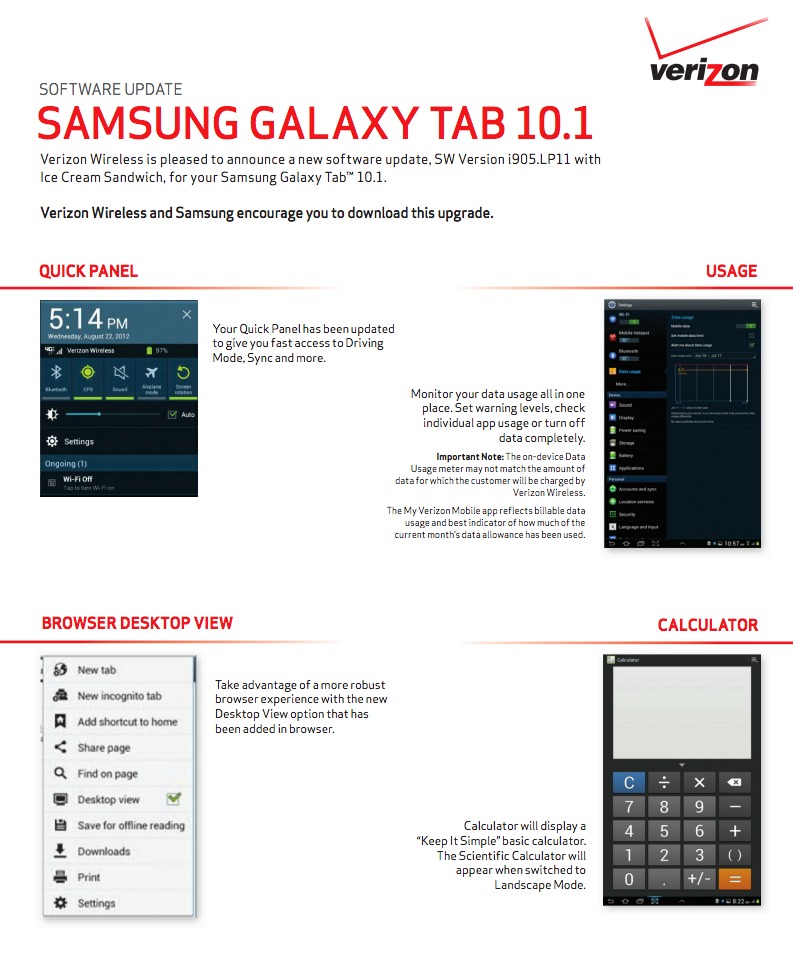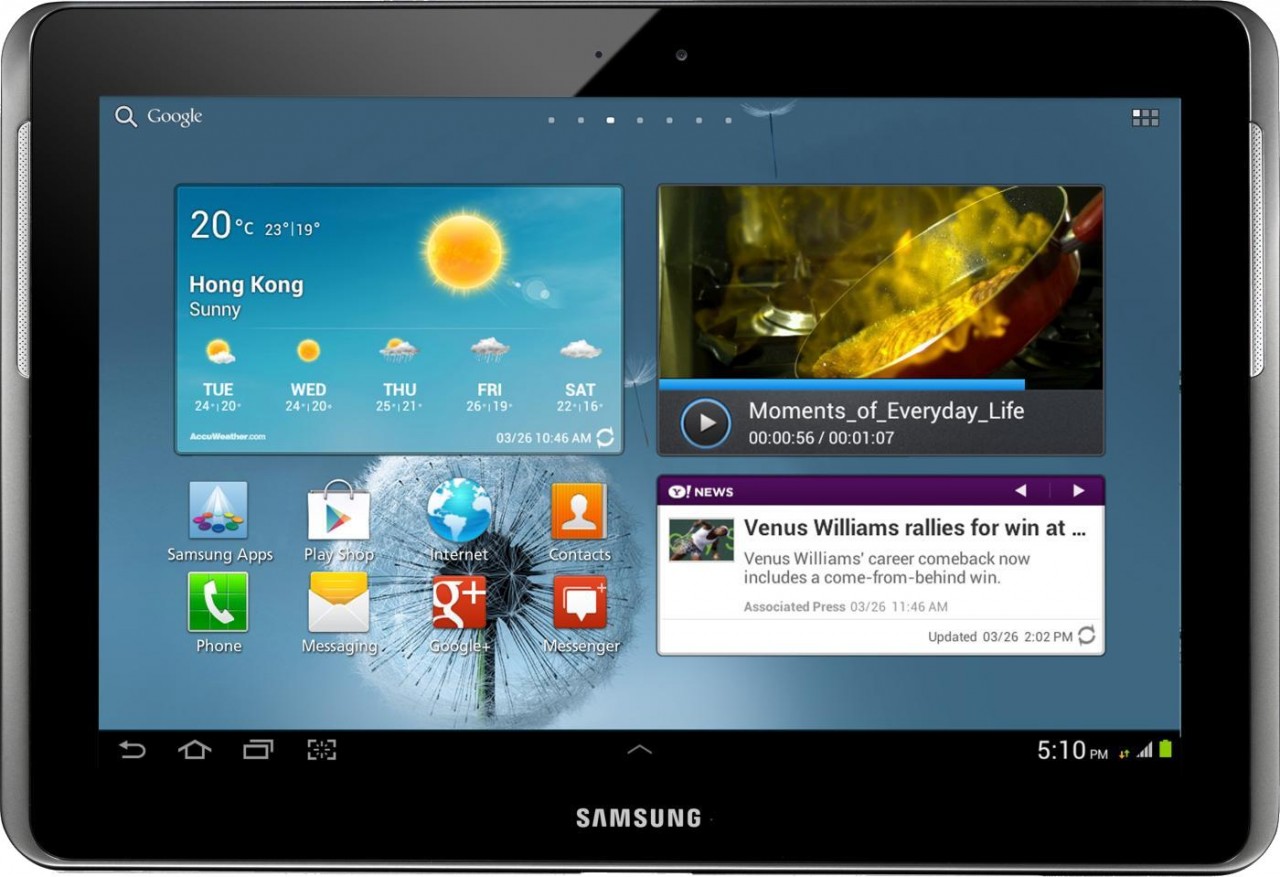11-05-2021
Samsung Galaxy Note 10.1 N8010 User Manual Pdf
Manual-User-Guide.com > Samsung phones › Specs Samsung Galaxy Note 10.1
Factory Data Reset (Powered Off) - Samsung Galaxy Note® 10.1 A factory data reset may help with a blank or frozen screen, apps crashing or freezing, keypad/touchscreen problems, can't hear, device making noises, can't make or receive calls, and device won't sync. The Samsung Galaxy Note 10.1 (2014 Edition) is a powerful 10-inch tablet with a high-resolution display. The display features a 2560 x 1600-pixel resolution, and under the hood there is an octa-core Samsung chip clocked at 1.9GHz for the 3G/Wi-Fi version or Snapdragon 800 for the LTE variant, and an impressive 3GB of RAM.
| Main display: PLS TFT 16M colors 800 x 1280 px (10.10″) 149 ppi |
| Android 4.0 Ice Cream Sandwich |
| 1,40 GHz |
| Li-Po 7000 mAh |
| Internal memory: 32 GB |
| RAM memory: 2 GB |
| 5 Mpx, 2592x1944 px |
153 User Reviews
| Other names: | GT-N8000 |
| Dimensions: | 180 x 262 x 8,9 mm |
| Weight: | 597 g |
| GSM frequencies: | 850/900/1800/1900 |
| Standard UMTS: | 850/900/1900/2100 |
| Standard battery: | Li-Po 7000 mAh |
| Stand-by (max.): | 2G: 1500 h |
| Talk time (max.): | 2G: 33,3 h |
| Internal memory: | 32 GB |
| RAM memory: | 2 GB |
| Memory cards: | microSD, microSDHC, microSDXC, max 64 GB |
| Operating system: | Android 4.0 Ice Cream Sandwich |
| Processor: | 1,40 GHz |
| Main display: | PLS TFT 16M colors 800 x 1280 px (10.10″) 149 ppi |
| Touchscreen: | Yes |
| Digital camera: | 5 Mpx, 2592x1944 px |
| Secondary camera: | 2 Mpx, 1600x1200 px |
| Flash: | Yes, LED |
| Video: | H.263, H.264, MPEG4, 1280x720 px |
| MP3: | Yes |
| Radio: | Yes |
| Dictionary: | Yes, XT9 |
| EMS: | - |
| MMS: | Yes |
| Speakerphone: | Yes |
| Voice dial: | Yes |
| Call forwarding: | Yes |
| e-mail client: | Yes |
| RSS Reader: | Yes |
| IrDA: | Yes |
| Bluetooth: | Yes, v4.0 |
| GPRS: | Yes, class 12 |
| EDGE: | Yes, class 12 |
| WiFi: | Yes, v802.11 a/b/g/n |
| Hotspot WiFi: | Yes |
| DLNA: | Yes |
| WAP: | Yes, v2.0 |
| xHTML: | Yes |
| HSCSD: | - |
| HSDPA: | Yes, 21,00 Mbit/s |
| HSUPA: | Yes, 5,76 Mbit/s |
| HSPA: | Yes |
| HSPA+: | Yes |
| LTE: | - |
| WiMAX: | - |
| USB | Yes, v2.0 |
| GPS: | Yes |
| GLONASS: | Yes |
| Push To Talk: | - |
| Java: | Yes, Dalvik |
| Calendar: | Yes |
| Watch: | Yes |
| Recorder: | Yes |
| Alarm: | Yes |
| Stopwatch: | - |
| Organizer: | Yes |
| Calculator: | Yes |
| Polyphony: | Yes |
Mobile terms glossary
GSM stands for Global System for Mobile Communication and is the most popular 2G mobile phone standard in the world.
GSM is used by about 80% of all mobile phones - approximately 2 billion people across more than 212 countries.
The widespread use of the GSM standard has made it easy for most mobile phone users to use their phones overseas thanks to roaming agreements between operators using the same GSM standard.
Samsung Galaxy Note 10.1 N8010 User Manual Pdf 2 8
GSM - then labelled Groupe Spécial Mobile was originally conceived back in 1982 as a European standard for mobile phones. The first GSM network went live in 1992 in Finland.GSM introduced the concept of the SIM card (Subscriber Identity Module card) - a detachable smart card that lets users swap their phone number and contacts between handset.
3G - Analog cellular phones were the first generation while digital marked the second generation.3G is loosely defined, but generally includes high data speeds, always-on data access, and greater voice capacity.
The high data speeds are possibly the most prominent feature, and certainly the most hyped. They enable such advanced features as live, streaming video.
There are several different 3G technology standards. The most prevalent is UMTS, which is based on WCDMA (the terms WCDMA and UMTS are often used interchangeably).
IrDA (Infrared Data Association) - A standard for transmitting data using an infrared port. Transfer speeds are roughly the same as traditional parallel ports. The industry group that created the IrDA technical standard.
Infrared connectivity is an old wireless technology used to connect two electronic devices. It uses a beam of infrared light to transmit information and so requires direct line of sight and operates only at close range.
IR was superseded by Bluetooth, which has the advantage of operating at longer distances (around 30 feet) and being omni-directional.
Many home devices such as TVs and DVD players still use IR remote controls. Some smartphones are capable of using their IR port to control these devises but that usually requires third-party software.
Bluetooth is a low-power wireless networking technology operating in the 2.4 GHz unlicensed Industrial, Scientific and Medical (ISM) band. There are two classes of Bluetooth device — Class 1 devices have higher output power and a range of about 100 meters, and Class 2 devices have lower power and a range of about 10 meters. Bluetooth enables ad hoc networking of up to eight devices (supporting voice and data). The Bluetooth Special Interest Group (SIG) was founded in 1998 by IBM, Intel, Ericsson, Nokia and Toshiba, and is supported by more than 2,500 organizations. The Bluetooth v.1.0 specification was ratified and published in 1999 and supported data rates of up to 1Mbps. Bluetooth Version 2.1, along with its enhanced data rate (EDR) specification, was ratified in March 2007, supporting data rates of up to 3 Mbps, and simplified “pairing” — the process used for securely linking one Bluetooth device to another. It also reduced power consumption, doubling the battery life of headsets and other mobile devices for which the Bluetooth radio consumes a large percentage of the power budget. Version 3.0 (“Seattle”) was adopted by the SIG in April 2009, and the specification included Wi-Fi as an alternative transport layer for large volumes of data, supporting data rates of up to 24 Mbps. The SIG also adopted “Bluetooth low energy,” a new ultra-low-power variant, previously referred to as Ultra Low Power (ULP) Bluetooth and Wibree.
GPRS
 stands for General Packet Radio Service and was the first popular data standard for mobile phones.
stands for General Packet Radio Service and was the first popular data standard for mobile phones.GPRS was used for WAP and MMS messages and offered modest connection speeds - typically 30-40 Kbit/s, although the theoretical maximum is 115 Kbit/s. GPRS is known as a 2.5G technology.
One of the early advantages of GPRS is that it s always on so no connection handshake is needed. It is still very popular, especially in the developing world.
The name of EDGE in full is Enhanced Data rates for GSM Evolution. This is a 2.75G technology further developed from the 2G and 2.5G technologies. Its data transmission speed is higher than that of GPRS and is closer to 3G technology.
Wi-Fi is a WLAN (Wireless Local Area Network) technology. It provides short-range wireless high-speed data connections between mobile data devices (such as laptops, PDAs or phones) and nearby Wi-Fi access points (special hardware connected to a wired network).
The older variant of Wi-Fi, 802.11g, is capable of providing speeds of up to 54Mbps and is backwards compatible with 802.11b (providing up to 11Mbps).
 The more recent standard is called 802.11n (offering speeds of up to 150Mbps per channel or up to 600Mbps in total). It can be used in the 2.4 GHz or 5 GHz frequency bands, though a receiver needs to have dual-band antenna to operate on both.
The more recent standard is called 802.11n (offering speeds of up to 150Mbps per channel or up to 600Mbps in total). It can be used in the 2.4 GHz or 5 GHz frequency bands, though a receiver needs to have dual-band antenna to operate on both.DLNA refers to both an organization and the technology they created. The DLNA standard is used for sharing music, photos and video over an existing home network. For example, by using DLNA you could stream video from your phone to a compatible TV-set using a Wi-Fi network.
Universal Serial Bus (USB) is a serial bus standard to interface computer peripherals. USB is quickly replacing the need for serial and parallel ports to interface devices.